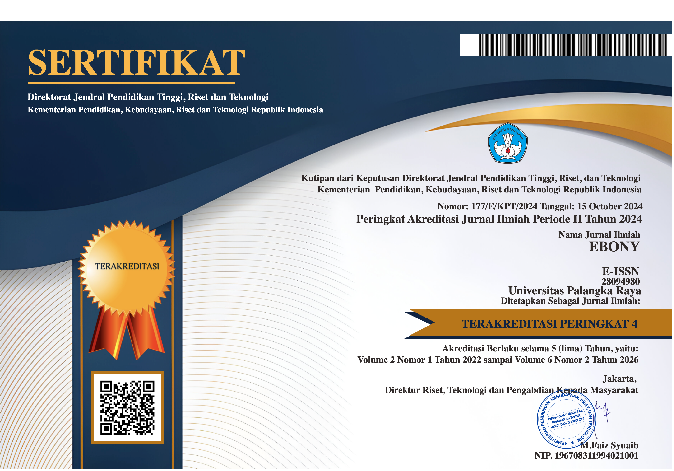Students’ Perception of Game-Based Learning Using Kahoot! In Learning English
DOI:
https://doi.org/10.37304/ebony.v4i1.12442Keywords:
Kahoot!, Game-Based Learning, Motivation, CompetitiveAbstract
This study aims to evaluate students' perceptions of the use of Kahoot! application in English learning and its impact on students' learning motivation in terms of its effectiveness and competitiveness,. This study used observation, questionnaire, and interview methods with 23 students in class XI Language of SMAN 1 Palangka Raya. The results showed that most students agreed that Kahoot! is an effective tool for English learning in class. Kahoot! increased their learning motivation through the Game-Based Learning (GBL) method, including competitive feeling, interactive learning, visual experience, fun learning, and customization. The results of this study show that Kahoot! is an effective learning tool to increase students' motivation in English learning. In addition, the use of Kahoot! can improve students' mood and help them understand the material more quickly also students feel more creative and enjoy learning due to the interactive and fun nature of the platform. The implication of this study is that students respond more positively to interactive, visual and fun learning media such as Kahoot! Teachers can consider using Kahoot! routinely in learning to improve students' motivation and learning outcomes. With this, Kahoot! is expected to be the learning tool whose influence has been sought.
Downloads
References
Adam, M. (2016, Desember 20). Role of Vocabulary Learning Strategies in Promoting EFL Learners Performance. Retrieved from SUST Repository: http://repository.sustech.edu/handle/123456789/15469
Adams-Goertel, R. (2013). Prosodic elements to improve pronounciation in English language learner: A short report. Applied Research on English Language, 117-128. DOI:10.22108/ARE.2013.15474
Adenekan, O. K. (2020). Navigating the Linguistic Terrain: Immigrants’ Personal Stories of Aspiration, Access, Identity, and Acclimation. Journal of Language & Literacy Education, 16(2), 1-35. Retrieved from https://eric.ed.gov/?id=EJ1285141
Ary, J. S. (2010). Inrtoduction to Research in Education. United Stated: Wadsworth Cengage Learning.
Asrori, A. (2014). Psikologi Remaja Perkembangan Peserta Didik. Jakarta: PT Bumi Aksara.
Bailey, M. (2020). Exploring Bem’s Self-Perception Theory in an Educational Context. Journal of Phenomenology and Education, 1-10. DOI:10.6092/issn.1825-8670/9891
Betts, J., Hill, L., Bachofer, K., Hayes, J., Lee, A., & Zau, A. (2019). English Learner Trajectories and Reclassification. Grantee Submission.
Bicen, H. (2018). Perceptions of Students for Gamification Approach:Kahoot as a Case Study. International Journal of Emerging Technologies in Learning, 72-93. DOI: https://doi.org/10.3991/ijet.v13i02.7467
Brown. (2004). Assesing Speaking. Cambridge.
Ciampa. (2014). Learning in a mobile age: an investigation of student motivation. Computer assisted learning, 82-96. Retrieved from https://eric.ed.gov/?id=EJ1029037
Clark, Q. (2016). Game-based Learning and 21st century skills: A review of recent reseaarch. Computers in Human Behaviour , 50-58. DOI:10.1016/j.chb.2016.05.023
Creswell. (2012). Planning, Conducting, and Evaluating Quantitative and Qualitative Research. New York: Pearson Education Inc. Retrieved from https://www.researchgate.net/publication/324451568_Educational_Research_Planning_Conducting_and_Evaluating_Quantitative_and_Qualitative_Research_6th_Edition
Debata, P. K. (2013). The Importance of Grammar in English Language Teaching: A Reassessment. Language in India, 482-486. Retrieved from https://www.researchgate.net/publication/279949868_The_Importance_of_Grammar_in_English_Language_Teaching_A_Reassessment
Duong, T. M. (2014). An Investigation into Effects of Role-play in an EFL Speaking Course. Global Journal of Foreign Language Teaching, 04(2), 81-91. Retrieved fromhttps://www.researchgate.net/publication/317958447_An_Investigation_into_Effects_of_Role-play_in_an_EFL_Speaking_Course
Fatimah, T., Mustajib, A., & Purnawati, S. (2019). CORRELATION BETWEEN STUDENTS’ VOCABULARY MASTERY AND STUDENTS’ SPEAKING ABILITY AT VIII GRADE OF SMP NEGERI 4 GAUNG ANAK SERKA. J-SHELVES OF INDRAGIRI, 55-65. DOI:10.32520/jsi.v1i1.803
Fauzi, I., Simbolon, M., & Mardiana, D. (2022a). Pelatihan Pengembangan Desain Pembelajaran Daring (Elearning) Bahasa Inggris Berbasis Aplikasi Whatsapp Bagi Guru SMP Negeri-3 Palangka Raya. Pengabdian Kampus: Jurnal Informasi Kegiatan Pengabdian Pada Masyarakat, 9(1), 11-19. DOI: https://doi.org/10.52850/jpmupr.v9i1.4672
Fauzi, I., Hartono, R., Widhiyanto, W., & Pratama, H. (2022b). Web-Based Language Learning: Benefits for Enhancing EFL Learners’ Speaking Skill. International Conference on Science, Education, and Technology, 8(1), 192–196. Retrieved from https://proceeding.unnes.ac.id/ISET/article/view/1749
Fuch. (2022). Bringing Kahoot! Into the Classroom: The Perceived Usefullness and Perceived Engagement of Gamified Learning in Higher Education. Information and Education Technology, 625-630. DOI:10.18178/ijiet.2022.12.7.1662
Gay, L. R., Mills, G. E., & Airasian, P. (2006). Educational Research: Competencies for Analysis and Applications. Columbus: Merrill Greenwood. Rretrieved from https://www.scirp.org/reference/referencespapers?referenceid=1914046
Gopalan J. A. (2017). A review of the motivation theories in learning. AIP Conference Proceedings 3, 1-7. DOI:10.1063/1.5005376
Hadijah, P. B. (2020). Interactive game “Kahoot!” as the media of students’ vocabulary assessment. Journal on English as a Foreign Language, 84-102. DOI: https://doi.org/10.23971/jefl.v10i1.1670
Hamad, M. M. (2013). Factors Negatively Affect Speaking Skills at Saudi Colleges for Girls in the South. English Language Teaching, 6, 87-97. DOI:10.5539/elt.v6n12p87
Hamali. (2016 ). Karakteristik keberagaman remaja dalam perspektif psikologi .
Harlina, Z. A. (2017). Pembelajaran Interaktif Berasaskan Aplikasi Kahoot. Seminar Serantau, 627-635. DOI: https://doi.org/10.24036/et.v2i2.101336
Hasanah, H. (2016). TEKNIK-TEKNIK OBSERVASI (Sebuah Alternatif Metode Pengumpulan Data Kualitatif Ilmu-ilmu Sosial). Jurnal Walisongo, 21-43. DOI: 10.21580/at.v8i1.1163
Hidayati, L., & Pardjono, P. (2018). The implementation of role play in education of pre-service vocational teacher. (pp. 1-5). IOP Conference Series: Materials Science and Engineering. DOI:10.1088/1757-899X/296/1/012016
Holbrey. (2020). Kahoot! Using a game-based approach to blended learning to support effective learning environment and student engagement in traditional lecture theatres. Technology, Pedagogy, and Education, 1-26. DOI:10.1080/1475939X.2020.1737568
Ifenthaler, E. (2012). Assessment for Game-Based Learning. New York: Springer. Retrieved from https://www.academia.edu/2763694/Assessment_for_Game_Based_Learning
Iman, R. & Saridewi. (2021). Kahoot as an Assessment Tools: Students' Perception of Game-Based Learning Platform. Jurnal Penelitian dan Pembelajaran IPA, 245-259. DOI: http://dx.doi.org/10.30870/jppi.v7i2.8304
Irawan, D. (2021). THE ROLE OF ASSISTANT PERFORMANCE MODERATION ON THE EFFECT OF THE FAMILY HOPE PROGRAM ON POVERTY ALLEVIATION IN TANJUNGBALAI CITY. Proceeding International Seminar on Islamic Studies, 138-147. Retrieved from https://jurnal.umsu.ac.id/index.php/insis/article/view/6224/pdf_153
Jiar, & Ramalinggam. (2022). Influence of Intrinsic and Extrinsic Motivation in Learning Among Primary School Students. 1884-1893. DOI:10.37178/ca-c.23.1.186
Johnson, & Rose. (2020). Contextualizing reliability and validity in qualitative research: toward more rigous and trustworthy qualitative social science in leisure research. Journal of Leisure Research, 1-20. DOI:10.1080/00222216.2020.1722042
Kacani, L., & Cyfeku, J. (2015, Desember 15). Developing EFL Vocabulary through Speaking and Listening Activities. Academic Journal of Interdisciplinary Studies, 4, 390-394. DOI:10.5901/ajis.2015.v4n3s1p390
Kassem, M. A. (2018, July). Improving EFL Students' Speaking Proficiency and Motivation: A Hybrid Problem-based Learning Approach. Theory and Practice in Language Studies, 8, 848-859. DOI:10.17507/tpls.0807.17
Kawulich, B. (2012). Collecting data through observation. 150-160. Retrieved from https://www.researchgate.net/publication/257944783_Collecting_data_through_observation
Khalek. (2016). Introduction to the Psychology of self-esteem. 1-23. Retrieved from https://www.researchgate.net/publication/311440256_Introduction_to_the_Psychology_of_self-esteem
Khan, M. I., Radzuan, N. R., Shahbaz, M., Ibrahim, A. H., & G. M. (2018). The Role of Vocabulary Knowledge in Speaking Development of Saudi EFL Learners. Arab World English Journal (AWEJ), 9 (1), 406-418. DOI:10.31235/osf.io/68gwj
Kilduff. (2014). Driven to Win: Rivalry, Motivation, and Performance. Social Psychological and Personality Science, 1-9. DOI:10.1177/1948550614539770
Korkmaz, S. Ö. (2021). Using Kahoot to improve reading comprehension of English as a foreign language learners. International Online Journal of Education and Teaching (IOJET), 1138-1150. Retrieved from https://www.acarindex.com/pdfler/acarindex-9d0240cc7ae57b055d02752110a5d184.pdf
Kuśnierek, A. (2015). Developing students’ speaking skills through. World Scientific News, 1, 73-111. Retrieved from https://www.scirp.org/reference/referencespapers?referenceid=2635663
Lai. (2011). Motivation: A Literature Review. Pearson. Retrieved from http://www.johnnietfeld.com/uploads/2/2/6/0/22606800/motivation_review_final.pdf
Licorish. O. D. (2018). Students' Perception of Kahoot!s influence on teaching and learning. Research and Practice in Technology Enhanced Learning, 1-23. DOI:10.1186/s41039-018-0078-8
Lin, G. &. (2018). Kahoot! It: Gamification in Higher Education. Social Sciences & Humanities , 565-582. Retrieved from http://www.pertanika.upm.edu.my/
Mart, Ç. T. (2012). Developing Speaking Skills through Reading. International Journal of English Linguistics, 2(6), 91-96. DOI:10.5539/ijel.v2n6p91
Moleong. (2017). Metode Penelitian Kualitatif. Bandung: Remaja Rosdakarya Offset.
Muliati, I., & Ismail, N. M. (2017). INTRICACIES IN VOCABULARY INTAKE FOR EFL ADULT LEARNERS. Retrieved from UBBG Institutional Repository: Retrieved from https://repository.bbg.ac.id/handle/459
Novianti, R. R. (2016). A Study Of Indonesian University Students’ Vocabulary Mastery With Vocabulary Level Test. Global Journal of Foreign Language Teaching, 6, 187-195. DOI:10.18844/gjflt.v6i4.1669
Oradee, T. (2012). Developing Speaking Skills Using Three Communicative Activities (Discussion, Problem-Solving, and Role Playing). International Journal of Social Science and Humanity, 2(6), 533-5-536. DOI:10.7763/IJSSH.2012.V2.164
Pekrun, R. (2014). Emotions and learning. Geneva, Switzerland: International Academy of Education (IAE). Retrieved from http://staging.iaoed.org/downloads/edu-practices_24_eng.pdf
Petri, G. a. (2016). How to Evaluate Educational Games: a Systematic Literature Review. Journal of Universal Computer Science, 992. Retrieved from https://lib.jucs.org/article/23357/
Plass, H. & Kinzer. (2015). Foundation of Game-Based Learning . Educational Psychologist , 258-280. DOI:10.1080/00461520.2015.1122533
Pratolo, B. W., Lofti, T. M. (2021). Students’ Perceptions Toward The Use of Kahoot! Online Game for Learning English. Ethical Lingua: Journal of Language Teaching and Literature, 8(1), 276-284. Retrieved from https://ethicallingua.org/25409190/article/view/250
Putra, A. S. (2017). THE CORRELATION BETWEEN MOTIVATION AND SPEAKING ABILITY. Channing: Journal of English Language Education and Literature, 2, 36-57. DOI: https://doi.org/10.30599/channing.v2i1.87
Rao, P. S. (2019). THE ROLE OF ENGLISH AS A GLOBAL LANGUAGE. Research Journal Of English (RJOE), 65-79. Retrieved from https://www.researchgate.net/publication/334282978_THE_ROLE_OF_ENGLISH_AS_A_GLOBAL_LANGUAGE
Ricci, L. a.-B. (2018). Qualitative Methods Used to Generate Questionnaire Item: A Systematic Review. Qualitative Health Research, 149-156. DOI: 10.1177/1049732318783186
Rodrigo-Ruiz. (2016). Effect of Teachers’ Emotions on Their Students: Some Evidence. Journal of Education & Social Policy , 73-79. https://www.researchgate.net/publication/311949229_Effect_of_Teachers'_Emotions_on_Their_Students_Some_Evidence
Roessler, L. (2011). Perception, Caution, and Objectivity. New York: Oxford University Press Inc. DOI:10.1093/acprof:oso/9780199692040.003.0001
Rukmini, D. (2017). THE AUTHENTIC ASSESSMENT TO MEASURE STUDENTS’ ENGLISH PRODUCTIVE SKILLS BASED ON 2013 CURRICULUM. Indonesian Journal of Applied Linguistics, 263-273. DOI:10.17509/ijal.v7i2.8128
Safitri. (2021). Students' Perception of The Use of Social Media For Learning English . 1-50. DOI:10.25134/ieflj.v8i2.6477
Samad, I. A., Bustari, A., & Ahmad, D. (2017). THE USE OF PODCASTS IN IMPROVING STUDENTS’ SPEAKING SKILL. Journal of English Language and Education, 3, 97-111. DOI:10.26486/jele.v3i2.256
Sani. (2014). Analisis Kemampuan Berpikir Kreatif Peserta Didik Dengan Memanfaatkan Lingkungan Pada Mata Pelajaran Ekonomi Di SMA Negeri 6 Palembang. Universitas Sriwijaya.
Simaibang, B., Mulyadi, & Lestari, W. (2017). THE CORRELATIONS AMONG VOCABULARY MASTERY, READING INTEREST AND READING ACHIEVEMENT OF THE TENTH GRADE STUDENTS OF SMA N 4 OF PALEMBANG. ELTE Journal, 5, 37-45. DOI: https://doi.org/10.31851/elte.v0i0.1377
Simatupang, N., & Lubis, F. (2020). Students' Reading Recount Text Mastery. English Journal for Teaching and Learning, 8(2), 155-165. DOI:https://doi.org/10.24952/ee.v8i2.3237
Spector, J. M. (2018). Motivation, learning, and technology:. New York: Routledge.
Sugiarto, P. (2021). Pemanfaatan Aplikasi Kahoot Sebagai Media Pembelajaran Anak Berbasis Game. Prosiding SNP2M UMAHA Vol 1 No 1, 102-105. DOI: https://doi.org/10.5281/zenodo.8388363
Sugiyono. (2019). Metode Penelitian Kuantitatif, Kualitatif dan R&D. Bandung: Alfabet.
Sulphey. (2017). Game Based Learning as an Aid for Extenuating Higher Education Sector Issues – . Game Based Learning as an Aid for Extenuating Higher Education Sector , 6.1-6.10. DOI:10.5013/IJSSST.a.18.01.06
Tahir., & Wang. (2020). The effect of using Kahoot! for learning – A literature review. Computers & Education, volume 149, 1-22. DOI:10.1016/j.compedu.2020.103818
Taslim, Asrifan, A., Chen, Y., & NR, N. (2019, August 28). Correlation Between Student's Vocabulary Mastery And Speaking Skill. Journal of Advanced English Studies, 2, 65-76. DOI: http://dx.doi.org/10.47354/jaes.v2i2.64
Uzer, Y. V. (2017, Desember). The Correlation between Vocabulary Mastery and English Speaking Ability of the Tenth Grade Students of Senior High School 12 Palembang. ANGLO-SAXON: Journal of the English Language Education Study Program, 8, 251-258. DOI: https://doi.org/10.33373/anglo.v8i2.1225
Wang, A. I. (2015). The wear out effect of a game-based student response system. Computers & Education, 217-227. DOI:10.1016/j.compedu.2014.11.004
Yingjie, Y. (2014). The development of speaking fluency: The 4/3/2 technique for the EFL learners in China. International Journal of Research Studies in Language Learning, 3(4), 55-70. DOI:10.5861/ijrsll.2013.624
Yusuf. (2011). Psikologi Perkembangan Anak & Remaja. Bandung: PT Remaja Rosdakarya.
Zhang, Z. Z. (2023). Intrinsic and Extrinsic Motivation in Distance Education: A Self-Determination Perspective. American Journal of Distance Education, 1-16. DOI:10.1080/08923647.2023.2177032
Downloads
Published
How to Cite
Issue
Section
License
Copyright (c) 2024 Fitria Gita Rahmadani, Tampung N Saman, Bahing

This work is licensed under a Creative Commons Attribution 4.0 International License.











